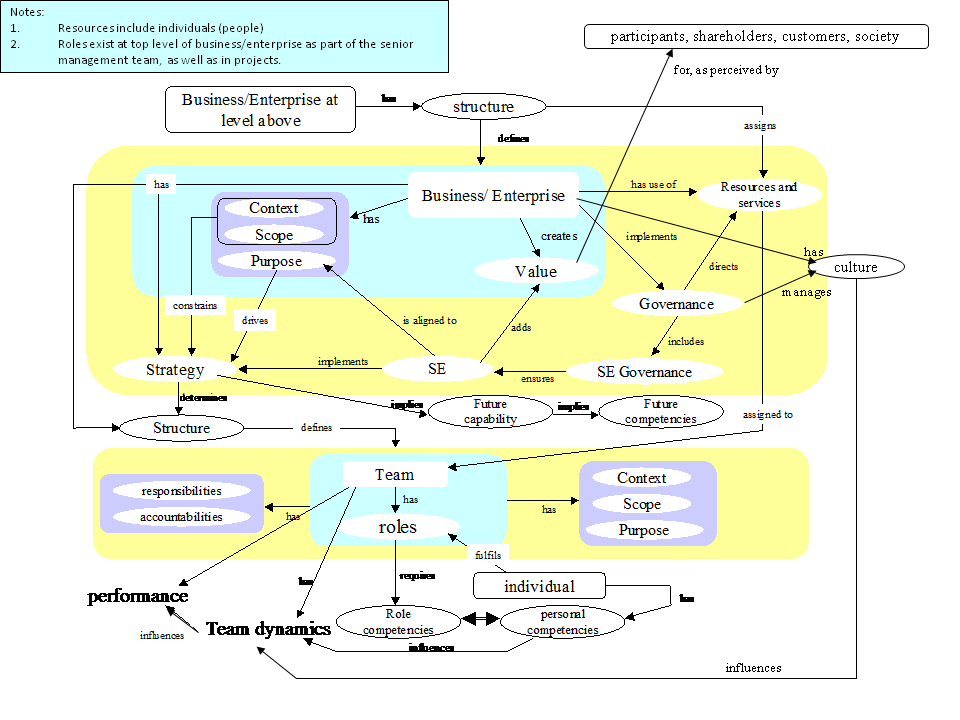Enabling Systems Engineering
SE activities that support an organization's needs and deliver intended value are enabled by many factors such as the organization's culture, SE workforce competencies, and how the organization grows and deploys its workforce armed with those competencies. There are as many different ways to enable SE performance as there are organizations - every organization's approach is, in detail, unique. Nevertheless, there are many common practices, methods, and considerations that organizations use, providing a framework to structure the relevant knowledge.
Beyond individuals, there are two levels of organizations defined in the SEBoK: team (which includes projects and programs among other types of teams) and business /enterprise (BE). Teams are usually formed for a specific limited duration purpose, such as creating a new system or upgrading an existing service or product. Once the new system has been created and delivered or the existing service or product has been upgraded and fielded, the team responsible for that effort is usually disbanded and the resources associated with that effort go on to new tasks. For example, the U.S. Federal Aviation Administration formed a team in the last decade to create a new enterprise resource planning system for its operations and dispersed the team after the system was fielded. However, there are exceptions; e.g., the U.S. Air Force's SE Center of Excellence persists indefinitely. On the other hand, BEs typically have permanence. They usually offer a portfolio of products and services, introducing new ones, retiring old ones, and otherwise taking steps to grow the value of the business or enterprise, however value is defined. Sometimes a single product or service has such value and longevity that it spawns a BE just for its creation, maintenance, and support; e.g., the Eurofighter Typhoon aircraft was developed by a consortium of three companies that formed a holding company specifically for this purpose. That holding company is expected to persist throughout the in-service life of the aircraft, providing support and upgrade services to the operators.
The primary structure of this Part is around BEs, teams, and individuals, with a fourth section at the beginning of the Part that articulates the overall strategy to enable SE to be performed well by a BE composed of teams and individuals.
Knowledge Areas in Part 5
- Systems Engineering Organizational Strategy
- Enabling Businesses and Enterprises to Perform Systems Engineering
- Enabling Teams to Perform Systems Engineering
- Enabling Individuals to Perform Systems Engineering
Concept map showing key relationships in Part 5
Key relationships among the key concepts in this Part are illustrated in the diagram below. BEs, teams, and individuals are the central concepts in the diagram. Some of the key points illustrated are:
- A BE has context, scope, and purpose.
- A BE creates value for its participants, shareholders, customers, society, and other stakeholders. The specific relevant stakeholders varies with the BE. The presumption, of course, is that SE activities add value to the BE and that value is greater when SE activities are well aligned to the BE context, scope, and purpose and operate consistent with the BE culture.
- A BE assigns resources and services to teams which themselves have context, scope, purpose, responsibilities, and accountabilities.
- Teams have various roles that require specific competencies for effective execution.
- Individuals who fill those roles have personal competencies.
- Teams have team dynamics that are influenced by the culture of the organization and by the specific individuals on the team and their competencies.
- Overall performance is driven by the team context, scope, and purpose, the team dynamics, and the team composition.
- A BE implements governance that includes SE governance to ensure that SE implements the overall strategy for the BE.
- The structure of the BE is driven, at least in part, by the strategy.
- Finally, there is an implicit recursion in the relationships between BEs, teams, and individuals; e.g., a BE which is a large global company may have component BEs, many of which may have further component BEs. A large program team may have component subprogram teams, many of which may have further component project teams, and so forth. Each level of the recursion is enabled and constrained to some degree by the structure, governance, context, and other concepts from both higher and lower levels. The specific nature of those constraints varies across organizations.
The four knowledge areas of this Part explore these relationships in more depth.
References
Please make sure all references are listed alphabetically and are formatted according to the Chicago Manual of Style (15th ed). See the BKCASE Reference Guidance for additional information.
Citations
List all references cited in the article. Note: SEBoK 0.5 uses Chicago Manual of Style (15th ed). See the BKCASE Reference Guidance for additional information.
Primary References
All primary references should be listed in alphabetical order. Remember to identify primary references by creating an internal link using the ‘’’reference title only’’’ (title). Please do not include version numbers in the links.
Additional References
All additional references should be listed in alphabetical order.
